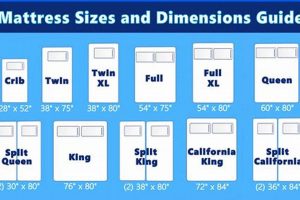Selecting an appropriately dimensioned sleeping surface is crucial for achieving optimal rest. Evaluating the different dimensional options available allows consumers to make informed decisions regarding their purchase. For instance, individuals may assess whether a standard queen size provides adequate space compared to the larger king size before making a final selection.
The ability to weigh different dimensional offerings is fundamental in ensuring comfort, accommodating individual sleep styles, and effectively utilizing available bedroom space. Historically, standardized dimensions have evolved to meet varying consumer needs and housing standards, streamlining the selection process and promoting product compatibility across different brands.
Therefore, a thorough understanding of available mattress dimensions, including length, width, and height, is essential before committing to a purchase. Factors to consider will include room size, budget, number of sleepers, and sleep preferences. Let’s delve into the specifics of each mattress type.
Guidance on Mattress Dimension Evaluation
Careful assessment of mattress dimensions is essential for a satisfying sleep experience. The following guidance facilitates the selection of the most suitable option.
Tip 1: Assess Room Dimensions. Prior to evaluation, measure the available space within the bedroom. Ensure adequate clearance for movement and other furniture placement after the mattress is installed. For example, a California King might be desired, but a small room might only accommodate a Full size.
Tip 2: Consider Sleeper Count. The number of individuals sharing the bed impacts dimensional needs. A single sleeper may find a Twin or Full adequate, whereas couples typically require a Queen, King, or California King for comfortable sleep.
Tip 3: Evaluate Sleep Style. Individuals who tend to sprawl or move frequently during sleep often benefit from larger dimensions. A King size could be beneficial for active sleepers.
Tip 4: Account for Frame Dimensions. Verify that the chosen mattress is compatible with the existing or planned bed frame. Bed frames are designed to fit specific mattress dimensions, ensuring proper support and stability.
Tip 5: Analyze Height Considerations. In addition to length and width, evaluate the mattress height, particularly if mobility limitations exist. A lower profile mattress might be more accessible for some individuals.
Tip 6: Budgetary Implications. Generally, larger dimensions correlate with higher purchase prices. Establish a budget prior to evaluating different options, ensuring affordability.
Tip 7: Long-Term Comfort. Consider long-term comfort and potential changes in needs. Selecting a slightly larger mattress, if feasible, may provide greater flexibility as individual circumstances evolve.
A thorough assessment of dimensions, sleeper needs, and available space contributes to a long-term, comfortable, and restful sleep experience. Consider these points when determining which mattress type is right for you.
The next section details the specific dimensions of common mattress types, allowing for a side-by-side comparison.
1. Width
Mattress width directly influences the sleeping comfort and personal space allocation per sleeper. When evaluating mattress dimensions, width is a primary consideration, particularly for couples or individuals who prefer ample room to move during sleep. Insufficient width can lead to restricted movement, disrupted sleep, and ultimately, reduced sleep quality. For instance, a standard Full-size mattress, measuring approximately 54 inches wide, may prove inadequate for two adults, resulting in discomfort and sleep disturbances.
The significance of width extends beyond individual comfort, impacting overall sleep quality and relationship harmony for couples. A wider mattress, such as a Queen (60 inches) or King (76 inches), provides increased personal space, mitigating disruptions caused by a partner’s movements. This translates to fewer awakenings during the night and improved restorative sleep. Additionally, the width dictates the feasibility of accommodating accessories, such as pillows or bedside tables, without encroaching on the sleep area.
In conclusion, the width dimension is a crucial factor in assessing mattress suitability. Adequate width ensures comfortable personal space, reduces sleep disruptions, and promotes overall sleep quality. Understanding the interplay between width and individual needs enables informed decisions, ultimately optimizing the sleep environment and enhancing well-being. Failure to consider width appropriately can lead to compromised sleep and diminished quality of life.
2. Length
Mattress length represents a critical dimension when evaluating suitable sleeping surfaces. The correspondence between mattress length and individual height directly affects sleep comfort and overall rest quality. Inadequate length can lead to discomfort, disrupted sleep patterns, and potential health implications. Therefore, assessing mattress length is an indispensable component of the mattress comparison process.
- Spinal Alignment and Support
Sufficient mattress length ensures proper spinal alignment during sleep. When a sleeper’s feet hang off the edge due to insufficient length, the spine can be subjected to unnatural curvature, potentially leading to back pain, discomfort, and long-term postural problems. Selecting a mattress with adequate length is essential to maintain a neutral spinal position throughout the night.
- Accommodation of Taller Individuals
Length becomes particularly significant for taller individuals. Standard mattress sizes may not adequately accommodate individuals exceeding a certain height, necessitating consideration of extended lengths such as those found in a Twin XL, Queen, King, or California King. The California King is designed specifically for taller individuals, providing extra length without the added width of a standard King.
- Impact on Sleep Quality
Restricted movement caused by insufficient length can negatively impact sleep quality. Individuals may unconsciously modify their sleep posture to compensate for the lack of space, resulting in muscle strain and disrupted sleep cycles. Opting for a mattress with appropriate length promotes unrestricted movement and contributes to deeper, more restorative sleep.
- Consideration of Bed Frame Compatibility
Mattress length must be compatible with the chosen bed frame. An incompatible pairing can lead to instability, damage to the mattress, and potential safety hazards. Ensuring that the mattress length aligns with the bed frame dimensions is crucial for structural integrity and long-term mattress performance.
Ultimately, the determination of appropriate mattress length involves a comprehensive evaluation of individual height, sleep habits, and bed frame specifications. Neglecting this critical dimension can result in compromised sleep quality and potential health repercussions. Thorough consideration of length, within the broader context of dimensional assessment, is essential for selecting a mattress that promotes optimal comfort and well-being.
3. Height
Mattress height, a critical dimension in the evaluation process, significantly influences both comfort and accessibility. When assessing mattress options, height interacts with other dimensions to determine the overall suitability of a sleeping surface. For example, a taller mattress, when paired with a high-profile bed frame, may present challenges for individuals with mobility limitations. Conversely, a low-profile mattress on a minimalist frame can provide an aesthetically pleasing and easily accessible sleep environment. Variations in mattress height are a primary differentiator between mattress types, affecting support, pressure relief, and the ease of getting in and out of bed. This interrelation underscores the importance of including height when considering dimensions.
A mattress’s height directly impacts the distribution and effectiveness of its internal components. A thicker mattress generally accommodates more layers of comfort and support materials, such as memory foam, latex, or innersprings. These additional layers can enhance pressure relief, contouring, and motion isolation. However, increased height also affects the overall weight and maneuverability of the mattress. Furthermore, the height impacts sheet compatibility. Deep-pocket sheets are often necessary for thicker mattresses, adding to the overall cost. Real-world scenarios illustrate the importance of this dimension. A side sleeper may benefit from a thicker mattress with enhanced pressure relief, while a stomach sleeper might prefer a thinner, firmer mattress for better spinal alignment.
In summary, mattress height is an integral aspect of the selection process. It affects accessibility, internal component distribution, overall comfort, and compatibility with bedding and bed frames. Failing to consider height can result in a sleeping surface that is either difficult to access, lacks adequate support, or is incompatible with existing bedroom furniture. Therefore, a comprehensive evaluation of mattress dimensions, including height, is essential for achieving optimal sleep quality and satisfaction.
4. Room Size
Room size is a crucial determinant in mattress selection. Physical dimensions of a bedroom directly influence the optimal mattress size that can be accommodated without compromising functionality or aesthetics. Overlooking the relationship between room size and mattress dimensions can lead to challenges in maneuverability, accessibility, and overall room comfort. The act of comparing mattress dimensions necessitates prior knowledge of the available space, effectively establishing an upper bound on potential options. For example, a California King mattress, while providing ample sleeping space, may overwhelm a smaller bedroom, restricting movement and making the room feel cramped.
Practical application of this understanding involves precise measurement of the room’s length and width, accounting for architectural features such as doorways, windows, and built-in furniture. These measurements serve as the foundation for evaluating different mattress sizes. Smaller rooms may necessitate the selection of a Twin or Full-size mattress, while larger rooms can comfortably accommodate Queen, King, or California King options. Beyond the physical fit, the visual impact of a large mattress in a small room should also be considered. A disproportionately large mattress can create an imbalance, diminishing the room’s overall aesthetic appeal. Conversely, a too-small mattress in a large room can appear lost and out of place.
In summary, room size is an indispensable component of the mattress selection process. It dictates the physically viable options and influences the aesthetic harmony of the bedroom. Accurate measurement and careful consideration of spatial dynamics are essential for achieving a balance between sleeping comfort and room functionality. The challenge lies in finding a mattress that not only meets individual sleep needs but also complements the existing room layout and design. Failure to adequately consider room size can result in a compromised sleeping environment and reduced overall quality of life.
5. Sleeper Count
The number of individuals regularly occupying a bed directly influences the required mattress dimensions. The relationship between sleeper count and mattress size is a deterministic factor in achieving adequate sleep quality and comfort for all occupants. An insufficient mattress dimension for a given sleeper count will inevitably lead to compromised personal space, increased motion transfer disturbances, and ultimately, reduced sleep efficiency. For instance, two adults sharing a Twin or Full-size mattress will likely experience disrupted sleep due to limited space and increased sensitivity to each other’s movements, whereas a Queen or King provides ample space for couples.
In practical terms, evaluating mattresses requires a clear understanding of the typical number of sleepers. Single sleepers often find Twin or Full sizes adequate, depending on their individual size and sleep preferences. Couples generally require a Queen, King, or California King. Co-sleeping with children introduces a more complex calculation, where the combined size and movement patterns of all sleepers must be considered. A King or California King becomes almost mandatory for a family sharing a bed to mitigate disruptions and ensure sufficient personal space. The correlation between sleeper count and mattress dimensions is not merely a matter of physical accommodation but also involves factors such as thermal regulation, as multiple bodies generate more heat within the sleeping environment.
Therefore, the significance of sleeper count in the context of mattress evaluation cannot be overstated. It is a primary input that shapes the decision-making process, dictating the minimum acceptable mattress size to facilitate comfortable and restful sleep for all occupants. Overlooking this crucial factor can lead to long-term sleep disturbances and reduced well-being. The challenge resides in accurately anticipating the typical sleeper count, accounting for potential variations such as occasional guests or children entering and leaving the bed throughout the night. This understanding forms the basis for a practical and informed approach to mattress selection.
6. Frame Compatibility
Frame compatibility is a fundamental consideration during mattress evaluation, acting as a limiting factor in the range of viable mattress dimension options. A mismatch between mattress and frame dimensions can compromise structural support, accelerate mattress degradation, and pose potential safety hazards. The practice of comparing mattress dimensions must, therefore, incorporate a thorough assessment of existing or planned bed frame specifications. An inappropriately sized mattress, regardless of its comfort attributes, will fail to perform optimally if inadequately supported by the frame. For example, a King-size mattress placed on a Queen-size frame will experience unsupported areas, leading to uneven wear and potential sagging. Conversely, a Twin-size mattress on a King-size frame will lack adequate support, creating an unstable and potentially dangerous sleeping surface.
Further implications of neglecting frame compatibility include voiding mattress warranties. Many manufacturers stipulate proper frame support as a condition of their warranty, and evidence of use with an incompatible frame can invalidate the warranty claim. The practical application of this understanding requires a detailed analysis of frame dimensions, weight capacity, and support structure. Bed frames often have specific requirements regarding center support beams, slat spacing, and overall weight distribution. Failure to adhere to these requirements can result in structural failure of the frame itself, further compromising the mattress. Resourceful consumers should consult both the mattress and frame manufacturers’ specifications to ensure dimensional and structural compatibility before finalizing a purchase.
In summary, frame compatibility is an inseparable element of mattress dimension comparison. It dictates the permissible range of mattress sizes, influences mattress longevity, and impacts overall sleeping safety. A systematic approach to frame assessment, coupled with meticulous attention to manufacturers’ guidelines, is crucial for achieving a stable, supportive, and durable sleep environment. The challenge lies in proactively identifying potential compatibility issues before purchase, thereby mitigating the risk of compromised sleep quality and avoidable financial losses. This proactive diligence is essential for a successful and long-lasting mattress investment.
7. Motion Transfer
Motion transfer, the propagation of movement across a sleeping surface, represents a significant consideration when evaluating suitable mattress dimensions. Its impact on sleep quality is particularly relevant when multiple individuals share a bed. The selection of appropriate dimensions can directly influence the minimization of motion transfer, thereby enhancing sleep quality for all occupants.
- Mattress Size and Surface Area
Larger mattress dimensions, specifically width and length, inherently provide a greater surface area across which motion can dissipate. A King-size mattress, for instance, offers significantly more space between sleepers than a Full-size, reducing the likelihood of one sleeper’s movements disrupting the other’s sleep. This relationship between size and motion isolation becomes a key factor in the mattress comparison process.
- Material Composition and Dampening
Certain mattress materials, such as memory foam and latex, possess inherent dampening properties that minimize motion transfer. These materials absorb and isolate movement, preventing it from spreading across the mattress surface. While material composition is independent of dimension, larger mattress sizes with motion-isolating materials offer a compounded benefit.
- Construction Techniques and Layering
The internal construction of a mattress, including the layering of different materials, can significantly influence motion transfer. Individually wrapped coils, for example, are designed to respond independently to pressure, reducing the propagation of movement compared to interconnected coil systems. The impact of these construction techniques is often more pronounced in larger mattress sizes.
- Edge Support and Perimeter Stability
Robust edge support and perimeter stability contribute to minimizing motion transfer, particularly near the edges of the mattress. A reinforced edge prevents excessive sinking or rolling, reducing the potential for movement to disturb a sleeping partner. Larger mattresses with enhanced edge support provide a more stable and consistent sleeping surface, further minimizing motion transfer effects.
Consequently, an informed comparison of mattress dimensions, specifically focusing on width and length, necessitates a parallel consideration of material composition, construction techniques, and edge support. The optimal combination of these factors, within the constraints of available space and budget, will yield a sleeping surface that minimizes motion transfer and promotes restorative sleep for all occupants. Evaluating all of these dimensions is crucial when purchasing a mattress.
Frequently Asked Questions
The following addresses common inquiries related to evaluating mattress dimensions for optimal sleep quality and comfort.
Question 1: What are the standard mattress dimensions?
Common mattress dimensions include Twin (38″ x 75″), Twin XL (38″ x 80″), Full (54″ x 75″), Queen (60″ x 80″), King (76″ x 80″), and California King (72″ x 84″). These measurements serve as a baseline for comparison and selection.
Question 2: How does sleeper count impact mattress dimension selection?
A single sleeper can typically utilize a Twin or Full-size mattress. Couples generally require a Queen, King, or California King to ensure adequate personal space and minimize sleep disturbances. The number of occupants directly correlates with the necessary surface area.
Question 3: Why is considering room size important when evaluating mattress sizes?
Room size dictates the maximum mattress dimensions that can be accommodated without compromising room functionality or aesthetics. Measuring the available space prior to mattress selection prevents overcrowding and ensures ease of movement within the bedroom.
Question 4: How does mattress height factor into the dimension evaluation?
Mattress height influences accessibility, particularly for individuals with mobility limitations. Additionally, it affects sheet compatibility and the overall aesthetic balance of the bed within the room. A comprehensive assessment includes considering mattress height relative to individual needs and preferences.
Question 5: What is the significance of frame compatibility in the mattress dimension comparison?
Frame compatibility ensures proper support and stability, preventing premature mattress degradation and potential safety hazards. An inappropriately sized frame can invalidate mattress warranties and compromise sleep quality. Verifying dimensional alignment between mattress and frame is crucial.
Question 6: How do mattress dimensions impact motion transfer?
Larger mattress sizes, specifically width, inherently provide greater separation between sleepers, minimizing the transmission of movement. Combined with motion-isolating materials, larger dimensions contribute to reduced sleep disturbances caused by a partner’s movements.
Accurate assessment of dimensions is crucial for a supportive, lasting, and satisfying sleep experience.
The following section summarizes the main points.
Compare Mattress Sizes
The preceding discussion underscores the importance of thorough evaluation when considering dimensions. Factors such as room size, sleeper count, frame compatibility, and individual sleep preferences collectively determine the optimal mattress size. Failure to adequately assess these factors can result in compromised sleep quality, accelerated mattress degradation, and potential safety hazards. Comprehensive comparison of mattress dimensions, therefore, represents a crucial step in the selection process.
A well-informed decision regarding mattress dimensions promotes long-term sleep comfort, enhances overall well-being, and represents a sound financial investment. Prioritizing dimensional assessment over superficial considerations ensures a sleeping environment that is both supportive and conducive to restorative rest. Engage in diligent research and meticulous measurement to secure a mattress that aligns with both spatial constraints and individual needs.


![Best Intex Queen Size Inflatable Mattress [Guide 2024] Organic & Natural Mattress Buyer’s Guide: Non-Toxic Sleep Solutions Best Intex Queen Size Inflatable Mattress [Guide 2024] | Organic & Natural Mattress Buyer’s Guide: Non-Toxic Sleep Solutions](https://mattressworldpa.com/wp-content/uploads/2025/07/th-2231-300x200.jpg)




